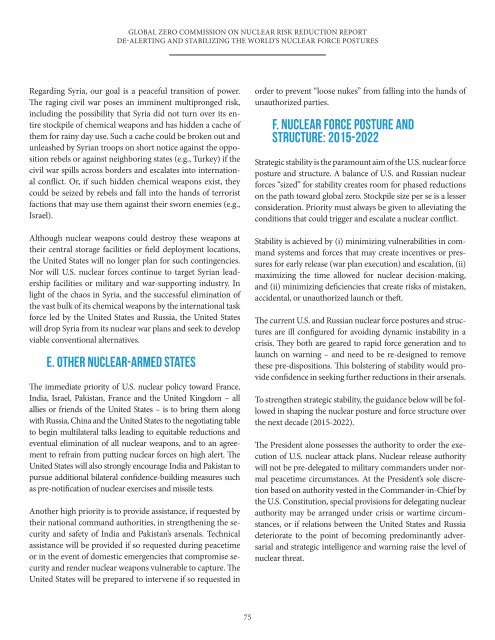global_zero_commission_on_nuclear_risk_reduction_report
global_zero_commission_on_nuclear_risk_reduction_report
global_zero_commission_on_nuclear_risk_reduction_report
You also want an ePaper? Increase the reach of your titles
YUMPU automatically turns print PDFs into web optimized ePapers that Google loves.
GLOBAL ZERO COMMISSION ON NUCLEAR RISK REDUCTION REPORTDE-ALERTING AND STABILIZING THE WORLD’S NUCLEAR FORCE POSTURESRegarding Syria, our goal is a peaceful transiti<strong>on</strong> of power.The raging civil war poses an imminent multipr<strong>on</strong>ged <strong>risk</strong>,including the possibility that Syria did not turn over its entirestockpile of chemical weap<strong>on</strong>s and has hidden a cache ofthem for rainy day use. Such a cache could be broken out andunleashed by Syrian troops <strong>on</strong> short notice against the oppositi<strong>on</strong>rebels or against neighboring states (e.g., Turkey) if thecivil war spills across borders and escalates into internati<strong>on</strong>alc<strong>on</strong>flict. Or, if such hidden chemical weap<strong>on</strong>s exist, theycould be seized by rebels and fall into the hands of terroristfacti<strong>on</strong>s that may use them against their sworn enemies (e.g.,Israel).Although <strong>nuclear</strong> weap<strong>on</strong>s could destroy these weap<strong>on</strong>s attheir central storage facilities or field deployment locati<strong>on</strong>s,the United States will no l<strong>on</strong>ger plan for such c<strong>on</strong>tingencies.Nor will U.S. <strong>nuclear</strong> forces c<strong>on</strong>tinue to target Syrian leadershipfacilities or military and war-supporting industry. Inlight of the chaos in Syria, and the successful eliminati<strong>on</strong> ofthe vast bulk of its chemical weap<strong>on</strong>s by the internati<strong>on</strong>al taskforce led by the United States and Russia, the United Stateswill drop Syria from its <strong>nuclear</strong> war plans and seek to developviable c<strong>on</strong>venti<strong>on</strong>al alternatives.E. OTHER NUCLEAR-ARMED STATESThe immediate priority of U.S. <strong>nuclear</strong> policy toward France,India, Israel, Pakistan, France and the United Kingdom – allallies or friends of the United States – is to bring them al<strong>on</strong>gwith Russia, China and the United States to the negotiating tableto begin multilateral talks leading to equitable reducti<strong>on</strong>s andeventual eliminati<strong>on</strong> of all <strong>nuclear</strong> weap<strong>on</strong>s, and to an agreementto refrain from putting <strong>nuclear</strong> forces <strong>on</strong> high alert. TheUnited States will also str<strong>on</strong>gly encourage India and Pakistan topursue additi<strong>on</strong>al bilateral c<strong>on</strong>fidence-building measures suchas pre-notificati<strong>on</strong> of <strong>nuclear</strong> exercises and missile tests.Another high priority is to provide assistance, if requested bytheir nati<strong>on</strong>al command authorities, in strengthening the securityand safety of India and Pakistan’s arsenals. Technicalassistance will be provided if so requested during peacetimeor in the event of domestic emergencies that compromise securityand render <strong>nuclear</strong> weap<strong>on</strong>s vulnerable to capture. TheUnited States will be prepared to intervene if so requested inorder to prevent “loose nukes” from falling into the hands ofunauthorized parties.F. NUCLEAR FORCE POSTURE ANDSTRUCTURE: 2015-2022Strategic stability is the paramount aim of the U.S. <strong>nuclear</strong> forceposture and structure. A balance of U.S. and Russian <strong>nuclear</strong>forces “sized” for stability creates room for phased reducti<strong>on</strong>s<strong>on</strong> the path toward <str<strong>on</strong>g>global</str<strong>on</strong>g> <str<strong>on</strong>g>zero</str<strong>on</strong>g>. Stockpile size per se is a lesserc<strong>on</strong>siderati<strong>on</strong>. Priority must always be given to alleviating thec<strong>on</strong>diti<strong>on</strong>s that could trigger and escalate a <strong>nuclear</strong> c<strong>on</strong>flict.Stability is achieved by (i) minimizing vulnerabilities in commandsystems and forces that may create incentives or pressuresfor early release (war plan executi<strong>on</strong>) and escalati<strong>on</strong>, (ii)maximizing the time allowed for <strong>nuclear</strong> decisi<strong>on</strong>-making,and (ii) minimizing deficiencies that create <strong>risk</strong>s of mistaken,accidental, or unauthorized launch or theft.The current U.S. and Russian <strong>nuclear</strong> force postures and structuresare ill c<strong>on</strong>figured for avoiding dynamic instability in acrisis. They both are geared to rapid force generati<strong>on</strong> and tolaunch <strong>on</strong> warning – and need to be re-designed to removethese pre-dispositi<strong>on</strong>s. This bolstering of stability would providec<strong>on</strong>fidence in seeking further reducti<strong>on</strong>s in their arsenals.To strengthen strategic stability, the guidance below will be followedin shaping the <strong>nuclear</strong> posture and force structure overthe next decade (2015-2022).The President al<strong>on</strong>e possesses the authority to order the executi<strong>on</strong>of U.S. <strong>nuclear</strong> attack plans. Nuclear release authoritywill not be pre-delegated to military commanders under normalpeacetime circumstances. At the President’s sole discreti<strong>on</strong>based <strong>on</strong> authority vested in the Commander-in-Chief bythe U.S. C<strong>on</strong>stituti<strong>on</strong>, special provisi<strong>on</strong>s for delegating <strong>nuclear</strong>authority may be arranged under crisis or wartime circumstances,or if relati<strong>on</strong>s between the United States and Russiadeteriorate to the point of becoming predominantly adversarialand strategic intelligence and warning raise the level of<strong>nuclear</strong> threat.75


